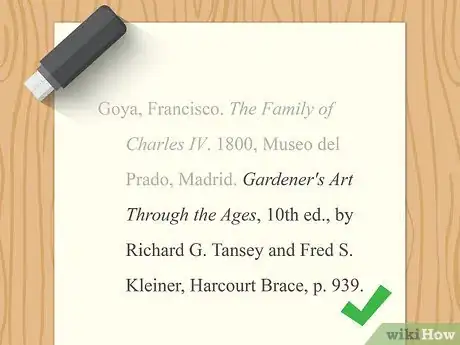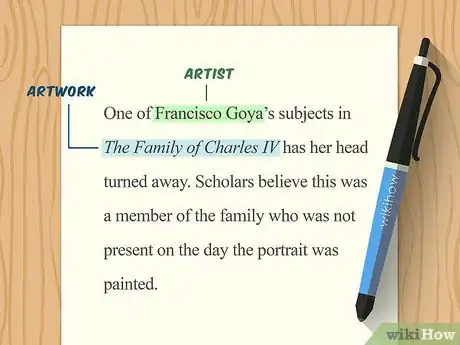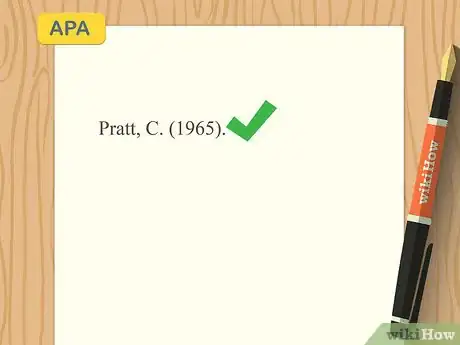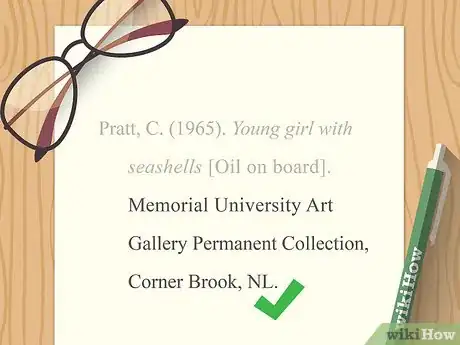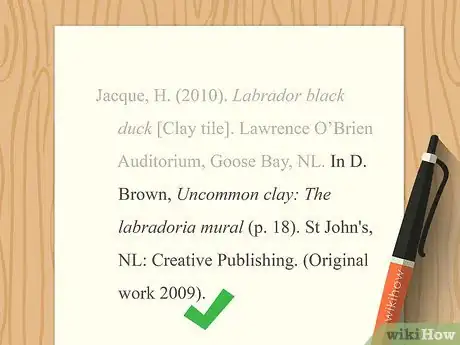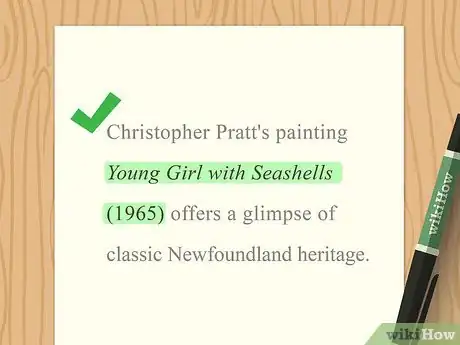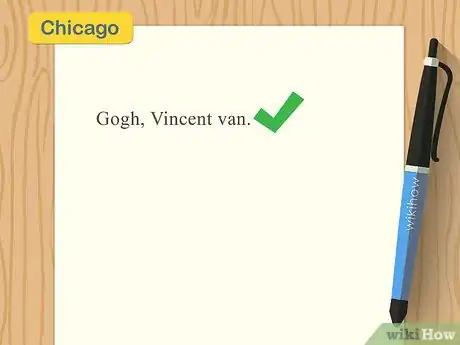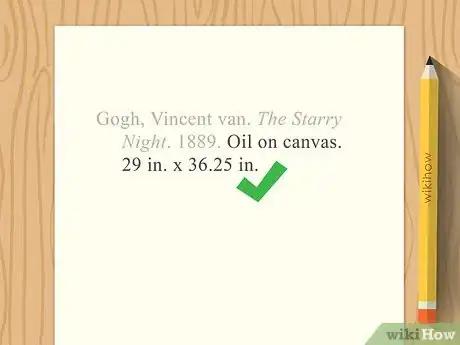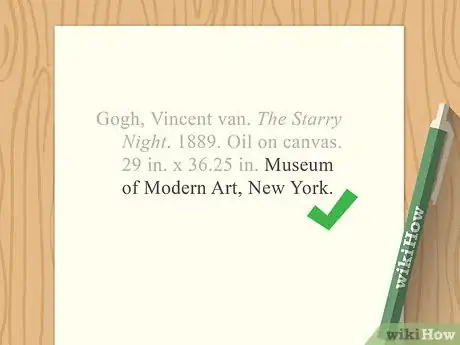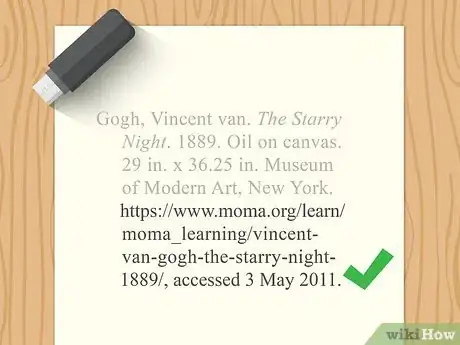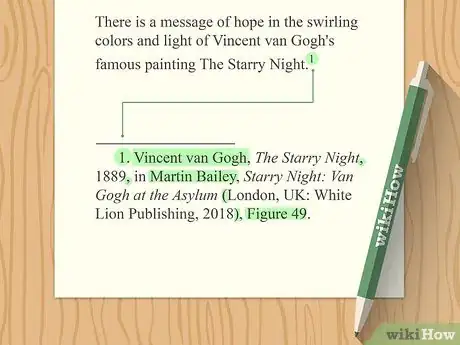This article was co-authored by wikiHow staff writer, Jennifer Mueller, JD. Jennifer Mueller is a wikiHow Content Creator. She specializes in reviewing, fact-checking, and evaluating wikiHow's content to ensure thoroughness and accuracy. Jennifer holds a JD from Indiana University Maurer School of Law in 2006.
There are 7 references cited in this article, which can be found at the bottom of the page.
This article has been viewed 109,539 times.
Learn more...
You may need to use a painting as a source for a research paper, particularly if you're writing about art history or a related field. To cite a painting, you need more information than you would for a standard text source. Typically, you'll also need to include the current location of the work, its dimensions, and its material or medium. The specific format for your citation varies depending on the citation style you use. Three of the most common citation styles are Modern Language Association (MLA), American Psychological Association (APA), and Chicago style.
Steps
MLA
-
1List the name of the artist first. For your Works Cited Entry, the artist is considered the "author" of a painting. Type their last name first, followed by a comma. Then type their first name. Include their middle name or initial, if provided, after their first name. Place a period at the end of their name.[1]
- Example: Goya, Francisco.
- If no artist is credited, start the citation with the title of the painting. If the work is credited to "Anonymous," use "Anonymous" as the artist's name.
-
2Type the title of the painting in italics. Type the title of the painting in title-case, capitalizing all nouns, pronouns, verbs, and adverbs. If the painting is untitled, type a brief, unitalicized description of the painting. Use sentence-case for a description, capitalizing only the first word and any proper nouns in your description. Place a period after the title or description.[2]
- Titled example: Goya, Francisco. The Family of Charles IV.
- Untitled example: Rauschenberg, Robert. Glossy black painting.
Examples of Brief Descriptions
Goya, Francisco. Untitled portrait of the Duchess of Alba.
Nicholson, Ben. White relief painting.
Basquiat, Jean-Michel. Black skull on blue background.
Advertisement -
3Provide the date of composition and the painting's location. Type the year the painting was created, followed by a comma. List the name of the museum or collection where the painting is housed. If the location of the museum or collection is not included in its name, type a comma and then the location. Place a period at the end.[3]
- Example: Goya, Francisco. The Family of Charles IV. 1800, Museo del Prado, Madrid.
MLA Works Cited Entry Format
Artist Last Name, First Name. Title of Painting. Year, Museum or Collection, City.
-
4Reference any book or website where the painting is located. If your source is actually a photographic reproduction of the painting in a book or on a website, include information about the book or website at the end of your citation.[4]
- Book example: Goya, Francisco. The Family of Charles IV. 1800, Museo del Prado, Madrid. Gardener's Art Through the Ages, 10th ed., by Richard G. Tansey and Fred S. Kleiner, Harcourt Brace, p. 939.
- Website example: Goya, Francisco. The Family of Charles IV. 1800, Museo del Prado, Madrid. WikiArt Visual Art Encyclopedia, www.wikiart.org/en/francisco-goya/charles-iv-of-spain-and-his-family-1800.
- If you viewed the painting on the museum's website, omit the name and location of the museum. Use the name of the website and URL instead. Place a period after the year, since it refers to the date the painting was created, not the date it was published on the website. For example: Goya, Francisco, The Family of Charles IV. 1800. Museo del Prado, www.museodelprado.es/en/the-collection/art-work/the-family-of-carlos-iv/.
- Include the medium and materials at the end of your entry if they are important or relevant to your paper. Otherwise, this information isn't required for an MLA Works Cited entry.
-
5Mention the artist and the artwork in the text of your paper. MLA style does not require parenthetical in-text citations for paintings. Instead, give the artist's name, followed by the title of the work in italics.[5]
- Example: "One of Francisco Goya's subjects in The Family of Charles IV has her head turned away. Scholars believe this was a member of the family who was not present on the day the portrait was painted."
- If the painting is untitled, use your brief description of the painting along with the artist's name. For example, you might write: "The Duchess of Alba was widely considered to be Francisco Goya's muse, as his many untitled portraits of her suggest."
APA
-
1Start with the name of the artist and the year of the painting. Type the artist's last name, followed by a comma. Then type the artist's first initial, followed by their middle initial, if available. Type the year the artist painted the work in parentheses. Place a period outside the closing parentheses.[6]
- Example: Pratt, C. (1965).
- If the artist is unknown, start your reference list entry with the title of the work. However, if the credited artist is "Anonymous," use that word as the name of the author.[7]
- If the date is not known, use the abbreviation "n.d." inside the parentheses.
-
2Provide the title of the painting and a description of the materials used. Type the title of the painting in italics. Use sentence-case, capitalizing only the first word and any proper nouns in the title. In square brackets, describe the materials or medium of the painting. Use sentence-case for the description as well. Place a period after the closing bracket.[8]
- Example: Pratt, C. (1965). Young girl with seashells [Oil on board].
- If the painting is untitled, use the word "Untitled" in place of the title. Since it isn't the title of the painting, it shouldn't be italicized.
-
3Include the location of the painting. Type the name of the museum, institution, or collection where the painting is housed. Place a comma, then type the name of the city, also followed by a comma. If the institution is located in the U.S. or Canada, add an abbreviation for the state or province. For all others, add the name of the country. Place a period at the end of your citation.[9]
- Example: Pratt, C. (1965). Young girl with seashells [Oil on board]. Memorial University Art Gallery Permanent Collection, Corner Brook, NL.
APA Reference List Entry Format
Artist Last Name, First Initial. (Year). Title of painting [Description of material]. Museum or Collection, City, abbreviated state/province or name of country.
-
4Add source information to cite a reproduction of a painting. If you viewed the painting in a book or online, rather than in person, include the author, title, date of publication, and publication information at the end of your reference list entry. Follow the same format as you normally would to cite a webpage or an article inside a book.[10]
- Book example: Jacque, H. (2010). Labrador black duck [Clay tile]. Lawrence O'Brien Auditorium, Goose Bay, NL. In D. Brown, Uncommon clay: The labradoria mural (p. 18). St John's, NL: Creative Publishing. (Original work 2009).
- Website example: Shepherd, H. P. (1962).Sunday morning [Oil]. Collection of Memorial University of Newfoundland, St. John's, NL. The rooms (n.d.). Retrieved from: http://www.therooms.ca/artgallery/shepherds.asp
-
5Put the year in parentheses after the title of the painting. Use the artist's name and the title of the painting within the text of your paper. Type the title in italics. Use title case, capitalizing the first word and all nouns, pronouns, verbs, and adverbs. After the title of the painting appears in your paper, type the year the painting was completed in parentheses.[11]
- Example: "Christopher Pratt's painting Young Girl with Seashells (1965) offers a glimpse of classic Newfoundland heritage."
Chicago
-
1List the artist's name first in your bibliography entry. Chicago style considers the artist (or painter) the "author" of the painting. Type the artist's last name, followed by a comma. Then type the artist's first name, followed by a period.[12]
- Example: Gogh, Vincent van.
- If the artist is unknown, simply leave this element out of your citation. If the artist is listed as "Anonymous," use that word in place of the artist's name.[13]
-
2Provide the title of the painting. Type a space after the period following the author's name, then type the title of the painting in italics. Use title case, capitalizing all nouns, pronouns, verbs, and adverbs. Place a period at the end of the title.[14]
- Example: Gogh, Vincent van. The Starry Night.
- If the painting is untitled, simply move on to the next element of the citation. Chicago doesn't require you to write a description as a placeholder, or to use the word "Untitled." However, if you do, type this information in plain text rather than italics. Otherwise, it looks like the title.
-
3List the date the work was created. After the title of the painting, type the year the painting was completed. If you don't have access to the year, you can either use the abbreviation "n.d." for no date or simply move on to the next element of the citation. Place a period after the year.[15]
- Example: Gogh, Vincent van. The Starry Night. 1889.
-
4Add information about the materials and dimensions of the work. After the year, provide a description of the materials used to create the painting. Use sentence-case, capitalizing only the first word and any proper nouns. Place a period after this description, then provide the dimensions of the work. Use standard abbreviations for the units of measurement. Place a period after the dimensions unless one is included after the abbreviation.[16]
- Example: Gogh, Vincent van. The Starry Night. 1889. Oil on canvas. 29 in. x 36.25 in.
- As with other elements, if any of this information isn't available, simply leave it out. There's no need to make a separate mention that the information is unknown or unavailable.
- The Chicago Manual of Style doesn't take a position on whether to use imperial or metric measurements. Simply pick one and use it consistently throughout your paper and other citations.
-
5Include the name and location of the museum or collection. After the dimensions, type the name of the museum, collection, or institution that houses the painting. Place a comma, then provide the name of the city where the museum, collection, or institution is located. Place a period after the name of the city.[17]
- Example: Gogh, Vincent van. The Starry Night. 1889. Oil on canvas. 29 in. x 36.25 in. Museum of Modern Art, New York.
-
6Close with the URL and date of access if you viewed the painting online. For paintings you looked at online, such as on a museum website, provide a full direct URL to the painting itself. Place a comma after the URL, then type the word "accessed." Indicate the date you last visited the URL in day-month-year format.[18]
- Example: Gogh, Vincent van. The Starry Night. 1889. Oil on canvas. 29 in. x 36.25 in. Museum of Modern Art, New York. https://www.moma.org/learn/moma_learning/vincent-van-gogh-the-starry-night-1889/, accessed 23 October 2018.
Chicago Bibliography Entry Format
Artist Last Name, First Name. Title of Painting. Year. Description of material. Dimensions. Museum or Collection, City. URL, accessed Day-Month-Year.
-
7Add a full citation for the source if you viewed the painting in print. Omit the medium and location for print reproductions of the painting. Begin with the word "In," then type the information you would normally include in a Chicago entry for the book or periodical where the painting was reproduced. End your citation with a period.[19]
- Book example: Gogh, Vincent van. The Starry Night. 1889. In Bailey, Martin. Starry Night: Van Gogh at the Asylum. London, UK: White Lion Publishing, 2018.
-
8Trade periods for commas in footnotes in the text of your paper. Flip the name of the artist so that the first name comes first. Include the same information as your bibliography entry, separated by commas rather than periods. The only period in a footnote comes at the end.[20]
- In-text example: "There is a message of hope in the swirling colors and light of Vincent van Gogh's famous painting The Starry Night.1"
- Footnote website example: 1. Vincent van Gogh, The Starry Night, 1889, oil on canvas, 29 in. x 36.25 in., Museum of Modern Art, New York, https://www.moma.org/learn/moma_learning/vincent-van-gogh-the-starry-night-1889/, accessed 23 October 2018.
- Footnote book example: 1. Vincent van Gogh, The Starry Night, 1889, in Martin Bailey, Starry Night: Van Gogh at the Asylum (London, UK: White Lion Publishing, 2018), Figure 49.
Community Q&A
-
QuestionHow do you cite a painting in APA?
 Drew Hawkins1Community AnswerType the artist's last name, followed by a comma. Then type the artist's first initial, followed by their middle initial, if available. Type the year the artist painted the work in parentheses. Place a period outside the closing parentheses. Then, type the title of the painting in italics, capitalizing only the first word and any proper nouns in the title. In square brackets, describe the materials or medium of the painting. Use sentence-case for the description as well. Place a period after the closing bracket. Type the name of the museum, institution, or collection where the painting is housed. Place a comma, then type the name of the city, also followed by a comma. If you viewed the painting in a book or online, rather than in person, include the author, title, date of publication, and publication information at the end of your reference list entry. Then, put the year in parentheses after the title of the painting.
Drew Hawkins1Community AnswerType the artist's last name, followed by a comma. Then type the artist's first initial, followed by their middle initial, if available. Type the year the artist painted the work in parentheses. Place a period outside the closing parentheses. Then, type the title of the painting in italics, capitalizing only the first word and any proper nouns in the title. In square brackets, describe the materials or medium of the painting. Use sentence-case for the description as well. Place a period after the closing bracket. Type the name of the museum, institution, or collection where the painting is housed. Place a comma, then type the name of the city, also followed by a comma. If you viewed the painting in a book or online, rather than in person, include the author, title, date of publication, and publication information at the end of your reference list entry. Then, put the year in parentheses after the title of the painting. -
QuestionHow do I cite a album cover art?
 Drew Hawkins1Community AnswerIt's actually not as tricky as you may think. Start with the artist's last name then their first name, and place a period after it. Then, write the title of the work in italics followed by a period. Type the date of the creation and follow that with a period. Then, type the institution and the city where the work is housed, separated by a comma and followed by a period. After that, type the name of the website you visited if that's where you found it, followed by a period. Write the word "Web" followed by a period after that and then put the date you accessed it, followed by a period. You can then add the URL in brackets if you like, but follow it up with a period if you do.
Drew Hawkins1Community AnswerIt's actually not as tricky as you may think. Start with the artist's last name then their first name, and place a period after it. Then, write the title of the work in italics followed by a period. Type the date of the creation and follow that with a period. Then, type the institution and the city where the work is housed, separated by a comma and followed by a period. After that, type the name of the website you visited if that's where you found it, followed by a period. Write the word "Web" followed by a period after that and then put the date you accessed it, followed by a period. You can then add the URL in brackets if you like, but follow it up with a period if you do. -
QuestionHow do you cite street art?
 Drew Hawkins1Community AnswerYou can absolutely cite graffiti or street art. You just need to follow the right format. Start with the title or description, with the graffiti artist's tag if there is one, in italics. Follow that with a period and then write the year in parenthesis, followed by a period as well. Then, write the location of the street art and add a period behind it. You can then write the date you viewed the art and close it off with a period. That's it!
Drew Hawkins1Community AnswerYou can absolutely cite graffiti or street art. You just need to follow the right format. Start with the title or description, with the graffiti artist's tag if there is one, in italics. Follow that with a period and then write the year in parenthesis, followed by a period as well. Then, write the location of the street art and add a period behind it. You can then write the date you viewed the art and close it off with a period. That's it!
References
- ↑ https://owl.purdue.edu/owl/research_and_citation/mla_style/mla_formatting_and_style_guide/mla_works_cited_other_common_sources.html
- ↑ http://guides.library.mun.ca/c.php?g=501606&p=3435023
- ↑ https://owl.purdue.edu/owl/research_and_citation/mla_style/mla_formatting_and_style_guide/mla_works_cited_other_common_sources.html
- ↑ https://owl.purdue.edu/owl/research_and_citation/mla_style/mla_formatting_and_style_guide/mla_works_cited_other_common_sources.html
- ↑ http://guides.library.mun.ca/c.php?g=501606&p=3435023
- ↑ http://guides.library.mun.ca/c.php?g=501606&p=3435051
- ↑ https://aus.libguides.com/apa/apa-no-author-date
- ↑ http://guides.library.mun.ca/c.php?g=501606&p=3435051
- ↑ http://guides.library.mun.ca/c.php?g=501606&p=3435051
- ↑ http://guides.library.mun.ca/c.php?g=501606&p=3435051
- ↑ http://guides.library.mun.ca/c.php?g=501606&p=3435051
- ↑ https://guides.highpoint.edu/c.php?g=19559&p=4947938
- ↑ https://librarybestbets.fairfield.edu/citationguides/chicagoauthor-date
- ↑ https://guides.highpoint.edu/c.php?g=19559&p=4947938
- ↑ https://guides.highpoint.edu/c.php?g=19559&p=4947938
- ↑ https://guides.highpoint.edu/c.php?g=19559&p=4947938
- ↑ https://guides.highpoint.edu/c.php?g=19559&p=4947938
- ↑ https://guides.highpoint.edu/c.php?g=19559&p=4947938
- ↑ https://aut.ac.nz.libguides.com/turabian/artworks
- ↑ https://guides.highpoint.edu/c.php?g=19559&p=4947938
About This Article
To cite a painting in the Modern Language Association style, you only need to give the artist’s full name followed by the title of the work in italics in the body of your essay. For example, you’d write, “In Francisco Goya’s The Family of Charles IV, he creates a contrast of light and dark.” For your works cited entry, you’ll need to write the artist’s name, starting with their surname, then the name of the painting in italics, followed by the year it was painted and the museum or collection where it’s located. If the city of the location isn’t included in the museum’s name, add this at the end. For instance, you would write, “Goya, Francisco. The Family of Charles IV. 1800, Museo del Prado, Madrid.” For more tips, including how to cite a painting using the APA and Chicago styles, read on!



